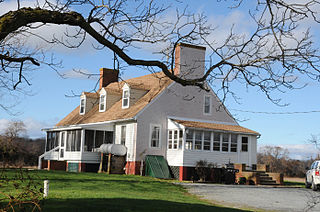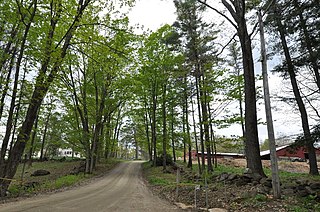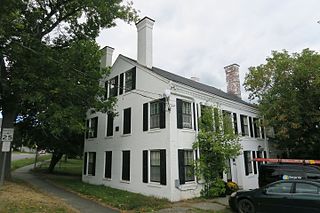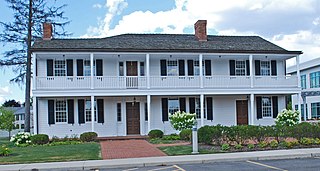
Bachelor's Hope is a historic house in Centreville, Maryland. Built between 1798 and 1815, it was added to the National Register of Historic Places in 1984.

The Caleb Cushing House and Farm is a historic farm property at 186 Pine Street in Rehoboth, Massachusetts. The farm, established about 1750, includes a pre-Revolutionary Georgian farmhouse and an 1836 Federal-Greek Revival Cape house, and was owned by the Cushing family into the mid-20th century. The property was listed on the National Register of Historic Places in 1983.

The Prince Osborne House is a historic First Period house in Danvers, Massachusetts. It is a 2+1⁄2-story wood-frame structure, five bays wide, with a side-gable roof and clapboard siding. Door and window trim is very simple, and there is a slight overhang of the second floor over the first. The house appears to have been formed out of two separate structures, that were, based on stylistic analysis, joined in about 1720. The left side of the house was probably built sometime between 1690 and 1700, but may be even older. In an unusual twist to this type of joinery, the older portion's chimney was taken down and a new one was apparently built in the framing of the newer section. The interior exhibits primarily later Federal period woodwork, but there are some examples of c. 1720 paneling.

The Capt. Leonard Tawes House is a historic home located at Crisfield, Somerset County, Maryland, United States. It is a frame two story house begun in the second quarter of the 19th century and extensively altered in the Late Victorian mode through the rest of the century. Also on the property is a garage, a storage shed, a stilted frame dairy, and a gable-roofed frame privy.

The John Hastings Cottage is an historic house at 31 William Street in Worcester, Massachusetts. Built about 1880, it is a distinctive example of Victorian Gothic architecture. The house was listed on the National Register of Historic Places in 1980, where it is misspelled as "Hastins".

The Roseberry Homestead, also known as the Walter Gess House, is a classic Georgian house, erected of rough-cut quarry stone between 1765 and 1783 in Phillipsburg, Warren County, New Jersey, United States. It is a 2+1⁄2-story, five-bay plan house, two rooms deep, with a center through hall. There is an attached 1+1⁄2-story stone kitchen, probably built before the main house. There are three chimneys—two rising from the gable ends of the main block, and the third from the gable end of the kitchen. There is a large cooking fireplace in the kitchen, with a removed brick oven. A winder stair on the fireplace wall leads to the loft above. The front of the house is on the downhill side, allowing for a walk-in cellar. A porch extended across the entire front, permitting access to the higher level first floor, but that has long since disappeared. John Roseberry, Sr. was one of the original settlers in Phillipsburg. It is very likely the oldest existing structure in town.

The house at 356 Albany Avenue in Kingston, New York, United States is a frame house built near the end of the 19th century. It is in the Queen Anne architectural style.

Avery House, in Griswold, Connecticut, also known as Hopeville Pond Park House, was built around 1770. The house is a 20 feet (6.1 m) by 40 feet (12 m), the two-story central-chimney Colonial that was originally sheathed in clapboard and topped with a gable roof. The central chimney is on a stone base and has a built-in root cellar. Alterations in the house changed the traditional five-room first floor plan by eliminating the keeping rooms and the removal of the kitchen fireplace. It retains much of its original door frames and wrought-iron latch hardware. After the rehabilitation of the property, the Avery House became the Hopeville Park manager's residence and is a part of the Hopeville Pond State Park. It was listed on the National Register of Historic Places in 1986.

West Cote is a historic home located near Howardsville, Albemarle County, Virginia. The house was built about 1830, and is a two-story, five-bay, brick dwelling. The front facade features a two-story, Tuscan order portico with paired full-height columns and no pediment.. Also on the property are a contributing office / guest house, smokehouse, well, corn crib, and stable.

The Gershom Durgin House is a historic house at 391 Franklin Highway in Andover, New Hampshire. Probably built between 1808 and 1820, it is a well-preserved example of an early 19th-century Cape Cod style house. It was listed on the National Register of Historic Places in 2000.

The Cullen Homestead Historic District encompasses a cluster of properties associated with the Cullen family in rural Somerset County, Maryland. Located in the center of Hopewell, just northeast of Crisfield, the district has three main features. The first is, known as the Cullen Homestead, is a c. 1820 Federal style wood frame dwelling. The building has retained much of its interior period woodwork, despite being added to and altered over the years, and has retained its original board sheathing under modern aluminum siding. The second house in the district is a later 19th century house built by Jacob Hoke Cullen in 1880. The oldest part of the house is a T-shaped portion, which was roughly mirrored by a later addition around 1910, giving the house its present H shape. This house has also retained interior and some exterior finish work. The third element of the district is the family cemetery.

The John Adams Homestead/Wellscroft is a historic farmstead off West Sunset Hill Road in Harrisville, New Hampshire. The oldest portion of the farm's main house is a 1+1⁄2-story wood-frame structure built in the 1770s. It is one of the least-altered examples of early Cape style architecture in Harrisville, lacking typical alterations such as the additions of dormers and changes to the window sizes, locations, and shapes. The farmstead, including outbuildings and an area of roughly 2 acres (0.81 ha) distinct from the larger farm property, was listed on the National Register of Historic Places.

The John Perry Homestead is a historic house at 135 Dooe Road in Dublin, New Hampshire. The 1+1⁄2-story Cape style farmhouse was built c. 1795 by John Perry, son of Ivory Perry who lived nearby. The house has been only minimally altered since its construction, with the replacement of windows and the addition of gable dormers being the most significant. The house was listed on the National Register of Historic Places in 1983.

The Henry Strongman House is a historic house at 1443 Peterborough Road in Dublin, New Hampshire. Built about 1770 by Dublin's first permanent white settler, it is a well-preserved example of a rural Cape style farmhouse. The house was listed on the National Register of Historic Places in 1983.

The Parsons Homestead is a historic house at 520 Washington Road in Rye, New Hampshire. Probably built about 1800 but including portions of older buildings, it is a well-preserved example of a distinctive local variant of the Federal style of architecture. It was listed on the National Register of Historic Places in 1980.

The Wardwell-Trickey Double House is a historic two-family residence at 97-99 Ohio Street in Bangor, Maine. Built in 1836, it is one of the least-altered early duplex brick houses in the city, in a form that war rarely seen in the state outside Bangor. The house was listed on the National Register of Historic Places in 1992.
The Farnsworth House is a historic house on Maine State Route 117 in North Bridgton, Maine. Built in 1825 for a local doctor, it is a particularly sophisticated example of Federal period architecture for a remote inland setting, featuring well-preserved interior woodwork. It was listed on the National Register of Historic Places in 1980.

The Botsford Inn is a nineteenth century inn and tavern located at 28000 Grand River Avenue in Farmington, Michigan. It was listed on the National Register of Historic Places in 1979.

The Edward Frisbie Homestead is a historic house at 240 Stony Creek Road in Branford, Connecticut, United States. Built about 1790 by the grandson of one of Branford's first settlers, it is a little-altered and well-preserved example of Federal period architecture. It was listed on the National Register of Historic Places in 1985.

The Brayton Homestead is a historic house at 159 Brayton Avenue in Somerset, Massachusetts. Built about 1796, it is one of Somerset's oldest surviving houses, and a rare local example of Georgian/Federal residential architecture. It was built by John Brayton on land purchased by his grandfather, and remained in the family into the 20th century. The house was listed on the National Register of Historic Places in 2020.






















